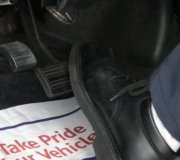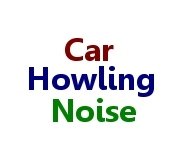Hi,
The idea that it nearly goes away when you turn right and is worse when turning left indicates it is likely a wheel bearing. What happens is this. When you turn, you shift the vehicle's weight more to one side. In this case, when you turn left, you are placing more of a load on the right front wheel bearing. When you turn right, you shift the weight to the left. Since it is nearly gone when you turn right, I suspect it is the right front bearing.
Please keep in mind, it could be a brake issue. However, you should hear a change in the sound when you apply the brakes. If that doesn't happen, then suspect the bearing.
_________________________________
Here are directions for the replacement of the hub bearing. It comes as a unit and bolts to the steering knuckle. The attached pictures correlate with the directions.
________________________________
2004 Buick Century V6-3.1L VIN J
Front Wheel Bearing and Hub Replacement
Vehicle Steering and Suspension Wheels and Tires Wheel Bearing Service and Repair Removal and Replacement Front Suspension Front Wheel Bearing and Hub Replacement
FRONT WHEEL BEARING AND HUB REPLACEMENT
Front Wheel Bearing and Hub Replacement
Tools Required
- J 42129 Wheel Hub Remover
Removal Procedure
1. Raise and support the vehicle. Refer to Lifting and Jacking the Vehicle.
2. Remove the tire and wheel. Refer to Tire and Wheel Removal and Installation See: Wheels and Tires > Procedures.
Pic 1
3. Disconnect the wheel speed sensor electrical connector (2), if equipped.
Pic 2
4. Remove the wheel speed sensor electrical connector from the bracket, if equipped.
Pic 3
5. Remove the front wheel drive shaft nut (2). Insert a drift or flat-bladed tool (1) into the caliper and rotor to prevent from turning.
6. Remove the brake rotor. Refer to Front Brake Rotor Replacement See: Brake Rotor/Disc > Procedures.
Pic 4
7. Use 3 wheel nuts in order to attach the J 42129 to the wheel bearing/hub.
8. Use the J 42129 in order to push the wheel drive shaft out of the wheel bearing/hub.
Pic 5
9. Remove and DISCARD the wheel bearing/hub bolts. Remove the J 42129 from the hub.
Important: Ensure that the wheel drive shaft outer seal/boot is not damaged.
10. Remove the wheel bearing/hub and splash shield-noting the position of the shield for re-installation.
Installation Procedure
pic 6
1. Install the wheel bearing/hub with the splash shield as noted during removal.
Caution: These fasteners must be replaced with new fasteners anytime they become loose or are removed. Failure to replace these fasteners after they become loose or are removed may cause loss of vehicle control and personal injury.
Notice: Use the correct fastener in the correct location. Replacement fasteners must be the correct part number for that application. Fasteners requiring replacement or fasteners requiring the use of thread locking compound or sealant are identified in the service procedure. Do not use paints, lubricants, or corrosion inhibitors on fasteners or fastener joint surfaces unless specified. These coatings affect fastener torque and joint clamping force and may damage the fastener. Use the correct tightening sequence and specifications when installing fasteners in order to avoid damage to parts and systems.
2. Install NEW wheel bearing/hub bolts.
Tighten
Tighten the NEW wheel bearing/hub bolts to 130 Nm (96 lbft).
3. Install the brake rotor and caliper. Refer to Front Brake Rotor Replacement See: Brake Rotor/Disc > Procedures.
4. Install the front wheel drive shaft nut. Insert a drift on a flat-bladed tool into caliper and rotor to prevent the rotor from turning.
Tighten
Tighten the front wheel drive shaft nut to 160 Nm (118 lbft).
Pic 7
Important: Ensure that the connector clip engages the bracket properly.
5. Install the wheel speed sensor electrical connector to the bracket, if equipped.
Pic 8
6. Connect the wheel speed sensor electrical connector (2), if equipped.
7. Install the tire and wheel. Refer to Tire and Wheel Removal and Installation See: Wheels and Tires > Procedures.
8. Lower the vehicle.
_______________________________________
If you could record it and upload it for me to hear, I will help me confirm my thoughts.
Let me know if this helps or if you have other questions.
Take care,
Joe
Images (Click to make bigger)
Friday, December 4th, 2020 AT 8:24 PM











